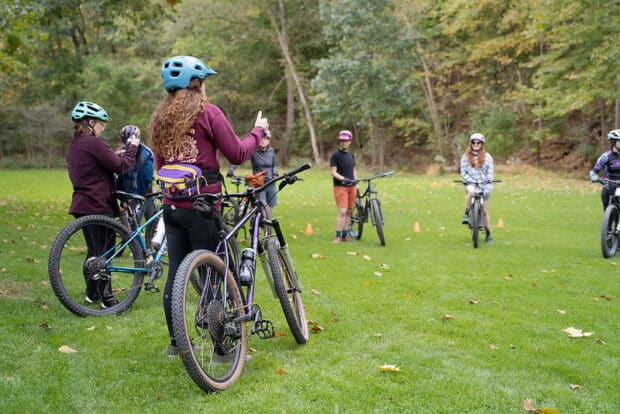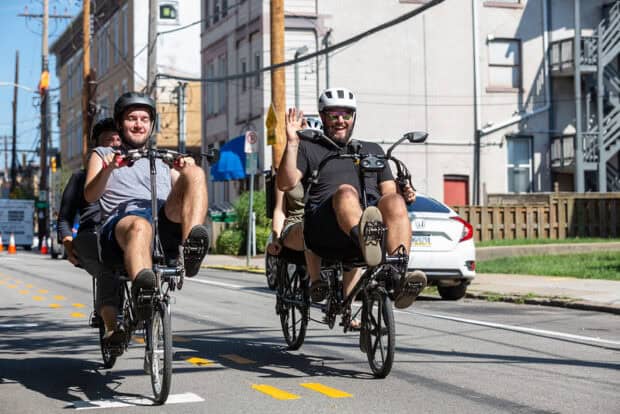by BikePGH Staff Contributor – DeAnna Srock

Bike joy is for everyone, no matter your experience level or what type of bike you ride. Too often, I hear the same concerns from people about not knowing if they will feel included at bike events in Pittsburgh. This is disheartening because the more people on bikes, participating in bike events and experiencing bike joy, the better for all of us.
That’s where you come in. An inclusive cycling community starts with each of us. How we make others feel welcome and safe (or not) is a huge part of building and growing an inclusive community. New and seasoned cyclists alike can benefit from checking in with themselves to see if they are upholding exclusionary ideas or welcoming and encouraging people to join the growing cycling community.
There’s no right cyclist or bike – Inclusive spaces welcome people as they are.
We all have opinions, carry judgments, and preconceived notions; that’s part of being human. When it comes to riding bikes, though, check yourself when it comes to what a cyclist is or what you think should be. Anyone riding any bike is a cyclist.
Much of the time, any bike is a good bike. If you want to go all out on a bike, gear, clothing, and accessories, go for it! if that’s what you want and what will allow you to show up and have a great time. Plenty of people are most comfortable riding in “normal” clothes and little to no specialty gear. What should matter most is being comfortable and equipped to ride. If someone’s bike fits them, they are comfortable and confident on it, they will have a much better experience than trying to fit in or conform. Let people express their bike identity how they want and keep your judgments to yourself.
Welcome E-bikes! Pittsburgh is hilly and can be an intimidating place to start or get back into riding. Even after commuting and touring for years, navigating Pittsburgh’s odd street layout and intense topography when I first moved here made me feel like I was a beginner all over again. If riding an e-bike allows someone to replace a few car trips a week or participate in community building group rides, then celebrate that it’s an option for someone. No more judgments or comments about “cheating” when riding an e-bike. E-bikes lower barriers to entry for so many people and can allow someone with limited physical mobility to discover or (rediscover!) and enjoy a favorite pastime. Welcome those riders, and be stoked they are riding!
A note on being safe: While someone’s preferred type of bike and how they want to dress when riding it is up to them, it is always wise to ensure you are equipped for safety on any ride you go on. There are limitations to what bikes can do and sometimes you do need a specific bike (you don’t want to go on a mountain bike ride on your fix gear with no brakes, for example).
Contact the organizers if you are attending a group ride or bike event for the first time and are unsure of what to expect. The last thing anyone wants is for someone to be unsafe and not have fun.

Best practices for hosting inclusive group rides
If you’re already hosting a group bike ride or want to start one, it’s key to ensure that people know about it and that you reach a diverse audience. Where are you sharing your ride information? Consider trying new or different platforms to get the word out about your ride, especially if you want to reach folks outside your immediate circle.
Remember these important guidelines to set clear expectations with attendees and allow them to opt in or out.
Info to share ahead of time: help people know what they are getting themselves into
- Route info
- Start & end location, total mileage and elevation change, terrain (what type of surface)
- Riding pace
- “Chill” and “casual” paces mean different things to just about everyone. Clearly state the average miles per hour the leader intends to ride at and stick to it.
- Drop vs no drop
- What do these terms mean?
- Drop rides do not wait for folks who may ride slower than the rest of the group or experience a mechanical issue. Basically, participants either keep up with the pace of the group or are left behind.
- No-drop rides mean nobody is left behind. Typically, someone “sweeps” the ride to make sure the entire group is together and offers support to anyone who may need it.
- No drop rides are the most inclusive since people won’t be left behind if they are riding slower than the rest of the group. Let people know about how often or where you’ll stop to regroup and ensure everyone is together. Give people time to catch their breath, hydrate and attend to anything their body or bike may need before moving on.
- If your ride is a drop ride and you won’t be stopping to regroup, ensure everyone knows that going in.
- What do these terms mean?
- Skill level
- Let people know what skill level the ride is best for – beginner, intermediate or advanced. Below is how we describe these skill levels to help communicate who a particular ride is best suited for.
- A beginner friendly ride is appropriate for people with less experience. This may be one of their first times on a group ride or riding a specific terrain.
- An intermediate ride is geared toward folks who have some experience or do these types of rides occasionally but are neither beginners nor advanced riders.
- Advanced rides are for people who are very comfortable or experienced with the type of riding, pace, or terrain. They’ve done this a number of times and are both equipped and comfortable with what’s planned.
- Let people know what skill level the ride is best for – beginner, intermediate or advanced. Below is how we describe these skill levels to help communicate who a particular ride is best suited for.
In person info to share: before your ride leaves, go over the following
- Roles
- Introduce the ride leader, caboose/sweep and any marshalls for the ride. Ensure people know their names and pronouns so they can ask them any questions that may come up.
- Skills & supplies –
- Is someone carrying basic bike maintenance tools and a pump? Make sure the group knows who that is and if they can help with minor mechanical issues.
- Review the route info, riding pace, drop vs no drop and skill level info.
- Help people be as informed as possible about what they are getting into. If this information is clearly shared, everyone will have more fun and be safer.
If you want to learn more about hosting inclusive group rides, check out Radical Adventure Riders Group Ride Guide for info, inspiration, and best practices. Our WMNBikePGH program has embraced and upheld many of these practices for years and recommend others do the same!

What else comes to mind when you think of how you can be a part of a more inclusive cycling community? Many publications and experts are out there to help you learn, is there one you’ve found particularly useful? Is there a community ride in Pittsburgh that deserves a shout-out?
Our community should embrace all of the above (and more) to get more people on bikes. We should all want to normalize bikes as everyday transportation and recreation options. The more inclusive and open our community, the more people will join the movement for safer streets.